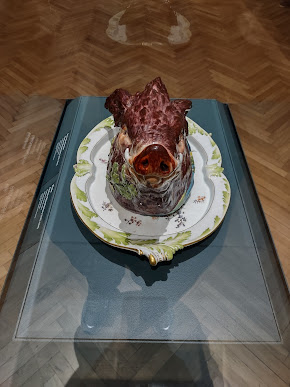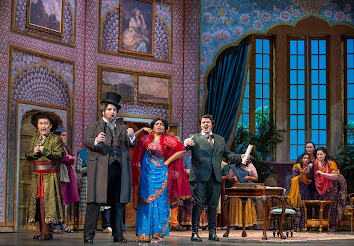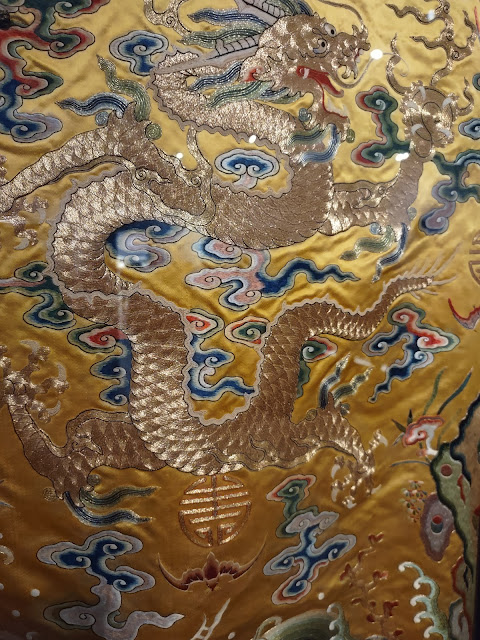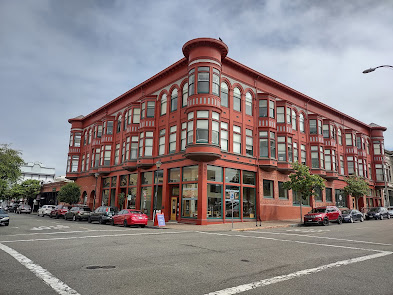Lisa Hirsch's Classical Music Blog.
The iron tongue of midnight hath told twelve. Lovers, to bed; 'tis almost fairy time.
Berce mollement sur ton sein sublime
Ô puissante mer, l’enfant de Dindyme!
Friday, September 30, 2022
Tuesday, September 27, 2022
Update on Openings at San Francisco Symphony
Well, last year's auditions for principal flute at SFS did not result in an appointment. The first two flute positions were filled over the season by Linda Lukas, Catherine Payne, and many guest artists, including Tim Day (former principal flute), Robin McKee (former associate principal flute), Sebastian Jacot, Denis Bouriakov, Érik Gratton, and others.
There's another round of auditions taking place this season. Resume submission was completed on September 12, with auditions to be held in November and February.
There are also auditions for principal harp, all in October.
Monday, September 26, 2022
Museum Mondays
Sunday, September 25, 2022
Thursday, September 22, 2022
SFS Appoints Matthew Spivey as CEO
Wednesday, September 21, 2022
Déjà Vu All Over Again, Orfeo ed Euridice Edition
First it was Julia Bullock, now it's Christina Gansch:
SAN FRANCISCO, CA (September 21, 2022) — San Francisco Opera announced today a cast change for its upcoming new production of Christoph Willibald Gluck’s Orpheus and Eurydice (Orfeo ed Euridice), opening November 15. Soprano Meigui Zhang will make her role debut as Eurydice, replacing Christina Gansch who is expecting her second child and has withdrawn from the production.
Meigui Zhang made her Company debut this past summer as Dai Yu (“sung with brightly quivering intensity,” San Francisco Chronicle) in Bright Sheng and David Henry Hwang’s Dream of the Red Chamber. The fast-rising soprano is featured in San Francisco Opera’s award-winning video portrait series, In Song. Released in June 2022, In Song: Meigui Zhang features Zhang reconnecting with her family in Chengdu, China and performing Eva Dell'Acqua's "Villanelle," Mozart’s “Das Veilchen” (“The Violet”) and the Kazakh folk song "A Lovely Rose."
Though Zhang’s journey as an opera singer began in Chengdu and continued in Shanghai, she also has a strong foundation in San Francisco, where she was a Merola Opera Program participant in 2018. After Merola, Zhang was selected to join the Metropolitan Opera’s Lindemann Young Artists Development Program. This spring, she reprised Barbarina in Mozart’s Le Nozze di Figaro at the Met and appeared as Thibault in that company’s new production of Verdi’s Don Carlos. Other recent credits include Pamina in Die Zauberflöte at the Verbier Festival, concert appearances with the Sichuan Symphony Orchestra on tour throughout China and Beethoven’s Ninth Symphony at Beijing’s National Centre for the Performing Arts.
Zhang joins the cast for Orpheus and Eurydice, which features countertenor Jakub Józef Orliński in his highly anticipated Company debut as Orpheus and soprano Nicole Heaston as Love (Amore).
San Francisco Opera’s new production of Gluck’s setting of the Orpheus myth presents the work in its original 1762 Viennese edition for the first time in Company history. Director Matthew Ozawa heads the creative team of set and projection designer Alexander V. Nichols, costume designer Jessica Jahn, lighting designer Yuki Nakase Link and choreographer Rena Butler in a production which traces Orpheus’ passage through the stages of grief at losing his beloved Eurydice. Artistic Director of the Irish Baroque Orchestra and founding Artistic Director of Ensemble Marsyas Peter Whelan makes his American operatic debut leading Gluck’s revolutionary score. Chorus Director John Keene prepares the Opera Chorus for the work’s exuberant and lamenting choruses.
The five performances of Orpheus and Eurydice are scheduled for November 15 (7:30 p.m.), 18 (7:30 p.m.), 20 (2 p.m.), 26 (7:30 p.m.); December 1 (7:30 p.m.), 2022.
Tuesday, September 20, 2022
Infinite Variety: Le Nozze di Figaro at Opera San José
What's the greatest opera ever written? This is a question that opera mavens love to debate. My own answer depends on which of my favorites I've seen most recently, which was lots of fun the summer I saw both Les Troyens and Tristan und Isolde. This week, though, it's Mozart's Le Nozze di Figaro (The Marriage of Figaro), which Opera San José is performing in a splendid new production set in India and directed by Brad Dalton.
I had some worries about the setting when I saw the season announcement, because it seemed as though there might be some pitfalls. But this production works brilliantly and succeeds on every musical and theatrical level.
It's not necessarily obvious to modern audiences how differently the servants and nobility in Nozze would have been dressed and would have behaved toward one another, especially with the leveling effect of Mozart's great score. But these differences are critical to the plot, because class conflict and the privileges of the nobility are right at the heart of the opera. Having the Count, Countess, and Dr. Bartolo in European dress and the servant class (actually including Marcellina, hmm) in Indian clothing made the distinction extremely clear.
Also, the production is absolutely gorgeous, a riot of color and pattern. The production includes dances based on Indian classical and folk dance, as well, and how I loved that! Claps and shouts of "hey!' added to the joyfulness of the scenes with dancing. It helps that several cast members are South Asian, too.
And overall, the direction is just fantastic; every gesture tells, characters are carefully delineated, the comings and goings in the Act 2 and 4 finales are clear, the funny bits are pretty darned funny. There are two exceptions: I do think that there was some kind of timing error in the last-act scene where Figaro and Susanna finally figure out that all is well between them. And there's the perennial problem of how to stage "Contessa, perdono" so that the audience doesn't laugh at this very serious moment. Directors need to take more time to show just how embarrassed and flustered the Count is, to persuade the audience that it's not a funny bit.
I was super-impressed by conductor Viswa Subbaraman. He took brisk tempos and they all worked; the overture was extremely exciting and the tempos throughout suited the nature of the direction. (Joshua Kosman notes some disconnect between pit and stage; he was at the third performance, and the issues persisted into the fourth. Hmm.) He had a great team of singers to work with, by and large. Efraín Solís is a hilariously deadpan Figaro. Maya Kherani a charming and lovable Susanna, singing beautifully in solos and duets. They were a delightful couple!
Eugene Brancoveneau's Count was really superb, never becoming a buffoon and strongly sun. Deepa Johnny was a hilarious Cherubino, getting in everyone's way, and she has a really lovely mezzo.
Melissa Sonhdi has an exceptionally beautiful light soprano and made a delightful Barbarina. Matthew Anchel was a forceful Dr. Bartolo, and what a beautiful dark bass he has! Tahanee Aluwihare matched him as Marcellina and (again), they were a great pair. My only doubts are about Maria Natale's Countess. She has a big, vibrant voice, maybe too big for the role in the smallish California Theater. Her singing was so large-scale as to push the audience away, rather than draw them in to the Countess's sadness over the state of her marriage. She did scale down for the duet with Susanna.
Two performances remain of this great masterpiece, which you'll be lucky to see in an equally vibrant and lively production, on Friday, September 23 at 7:30 p.m. and Sunday, September 25 at 2 p.m. Be warned that the area around the theater is part of a pedestrian-only area on Sundays; you will not be able to drop passengers off at the theater.
- Joshua Kosman, Chronicle
- Opera Tattler
Monday, September 19, 2022
Antony and Cleopatra: Media Round-Up
- Joshua Kosman, San Francisco Chronicle
- Zachary Woolfe, NY Times.
- Georgia Rowe, Opera News
- Lisa Hirsch, SFCV
- Alex Ross, The New Yorker
- Mark Swed, LA Times
- John Rockwell, Financial Times
- Nicholas Kenyon, Telegraph
- Heidi Waleson, WSJ
- Thomas May, Musical America
- Richard Ginell, CVNA
- Opera Tattler, Opera Tattler (again)
- Michael Anthonio, Parterre Box
- Patrick Vaz, The Reverberate Hills
- Michael Strickland, SF Civic Center
- Jari Kallio, Adventures in Music
Museum Mondays
Friday, September 16, 2022
Jorja Fleezanis
Violinist and pedagogue Jorja Fleezanis died last weekend at only 70. She was associate concertmaster of the San Francisco Symphony, then went on to be concertmaster of the Minnesota Orchestra for some 20 years. John Adams wrote his first violin concerto for her. She retired in 2009 after the death of her husband, the musicologist and program annotator Michael Steinberg, and began teaching at Indiana University.
David Allen's NY Times obituary has this choice bit in it:
Ms. Fleezanis at first looked likely to break barriers at the San Francisco Symphony, which she joined as a second violinist in 1980, becoming its associate concertmaster in 1981. Sharing the first stand with Raymond Kobler, she played so “splendidly,” the critic Robert Commanday wrote in The San Francisco Examiner in 1988, that she struck observers “as the stronger of the two, and often the real leader of the section.”
In a decision that Mr. Commanday described as “not very defensible,” the San Francisco Symphony’s music director, Herbert Blomstedt, stuck with his man, even after it became clear that the cost would be Ms. Fleezanis’s departure. She accepted the overtures of Mr. Blomstedt’s predecessor, Edo de Waart, who was eager to bring her to his new ensemble, the Minnesota Orchestra.
Right you were, Bob. (It took MTT a few years to dislodge Kobler and then a couple more to hire Alexander Barantschik, who remains the concertmaster of SFS.)
I heard Fleezanis in her associate concertmaster role in the 1980s, but I had virtually no awareness of who the individuals in the orchestra were or how important the upper seats of the violin section are. I heard her in chamber music once, a great performance of the Brahms piano quintet at Music@Menlo in 2005 in which she was the first violinist. The other players were Ian Swenson (2nd violin), Cynthia Phelps (viola), Ralph Kirschbaum (cello), and Wu Han (piano).
Thursday, September 15, 2022
Opera Parallèle 2022-23 Season
Opera Parallèle announced its oddly-number 2022-23 season, all performances of which seem to take place in 2023. There are just two works next year but they are goodies:
- Everest: An Immersive Experience, by Joby Talbot with a libretto by Gene Scheer. During the earlier stage of the pandemic, OP created a video version of this. I never saw it, though I will try to see it in the near future. I loved Talbot's Path of Miracles, performed by Volti and ODC Dance in 2018. This opera is based on interviews and other accounts of the 1996 Mt. Everest climbing disaster covered by Jon Krakauer in Into Thin Air. Now it's being staged as a completely immersive experience at Z Space. Intruiging and well cast, with Sasha Cooke, Nathan Granner, Kevin Burdette, Hadleigh Adams, and more. February 3-12, 2023.
- The Shining, by Paul Moravec with a libretto by Mark Campbell. Based on the Stephen King novel; a co-production with Hawai'i Opera Theatre and Opera Portland. June 2-4, 2023. Edward Parks, Kearstin Piper Brown, Aubrey Allicock, and others star. This one is at YBCA Theatre.
Monday, September 12, 2022
Friday, September 09, 2022
Monday, September 05, 2022
Friday, September 02, 2022
Friday Photo
Thursday, September 01, 2022
Disparate Health & Safety Requirements
At San Francisco Opera, policy updated August 25, 2022:
Updated August 25, 2022
All patrons aged 5 and older must show proof of full vaccination (defined as two weeks after your final shot), along with a matching photo ID. If bringing a child under the age of 5, who is not eligible for the vaccine, please call the Box Office to purchase tickets. Children under the age of 5 will be required to show proof of a negative "rapid" antigen test taken within one calendar day prior to entry or a negative PCR test taken within two calendar days prior to entry.
For information on how to get a vaccine, visit https://covid19.ca.gov/vaccines
All patrons must wear well-fitted masks that cover their nose, mouth, and chin when inside the facility unless they are actively eating or drinking. A non-vented N95 mask is strongly recommended as a well-fitted mask to provide maximum protection. A well-fitted mask does not include a scarf, ski mask, balaclava, bandana, turtleneck collar, single layer of fabric or any mask that has an unfiltered one-way exhaust valve. Audience members who fail to follow the Front of House safety protocols will be promptly removed from the performance venue.
At San Francisco Symphony:
PATRON SAFETY AT DAVIES SYMPHONY HALL
The health and safety of our patrons, musicians, staff, and volunteers is our top priority. This page will be updated on an ongoing basis.
(Updated August 9, 2022)
MASK REQUIREMENTS
Based on the advice of the San Francisco Symphony’s Health and Safety Task Force, a face covering is recommended but no longer required for entry into Davies Symphony Hall. There will be a limited number of KN95 or equivalent masks available at Davies Symphony Hall for those patrons that request them.
VACCINATION POLICY
Patrons 12 and older must show proof of full vaccination (electronic, photo, or paper copy).
Patrons under age 12 must show proof of full vaccination or a negative COVID-19 test (PCR test taken within 2 days of event entry or an antigen [rapid] test taken within 1 day of event entry. See “Testing Requirements” below for more information.
“Full vaccination” is defined as two weeks after completion of the two-dose regimen of Pfizer or Moderna vaccines, one dose of Johnson & Johnson vaccine, or other WHO authorized COVID-19 vaccine. At this time, proof of booster shots is not required.
The San Francisco Symphony requires full vaccination for all musicians, staff, and volunteers to participate in any Symphony-sponsored activities at Davies Symphony Hall, Zellerbach Rehearsal Hall, or any other locations of such activities.
You can guess that I'm a lot happier about SF Opera's mask-required policy, which will limit the spread of COVID if anyone in the WMOH is infected. Come ON, SFS, what are you thinking? You have many more programs and more opportunities to spread the coronavirus. Go back to requiring masking. It's better for us all.
MTT on the East Coast
- David Allen, NY Times, writes about MTT at Tanglewood and reviews a program of his.
- Javier C. Hernandez, NY Times, interviews MTT and writes about his career.
- Jeremy Eichler, Boston Globe, talks with MTT.
- Christopher Benfy, Boston Globe, reviews one of his Tanglewood programs.
- Kevin Wells, Bachtrack, reviews LvB 9th.




















-Brandon-Patoc-larger.jpeg)